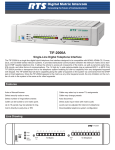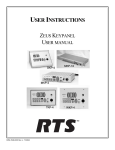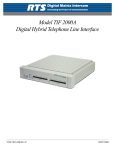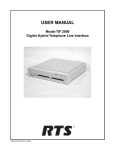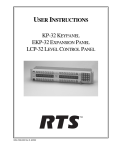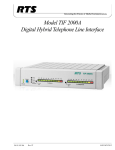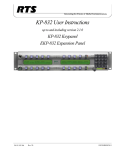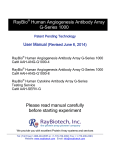Download CSI-200 User Instructions.book
Transcript
USER INSTRUCTIONS MODEL CSI-200 COAXIAL SYSTEM INTERFACE 9350-7676-000 Rev B, 5/2001 PROPRIETARY NOTICE The RTS product information and design disclosed herein were originated by and are the property of Telex Communications, Inc. telex reserves all patent, proprietary design, manufacturing, reproduction, use and sales rights thereto, and to any article disclosed therein, except to the extent rights are expressly granted to others. COPYRIGHT NOTICE Copyright © 2000 by Telex Communications, Inc. All rights reserved. Reproduction in whole or in part without prior written permission from Telex is prohibited. UNPACKING AND INSPECTION Immediately upon receipt of the equipment, inspect the shipping container and the contents carefully for any discrepancies or damage. Should there be any, notify the freight company and the dealer at once. WARRANTY INFORMATION RTS products are warranted by Telex Communications, Inc. to be free from defects in materials and workmanship for a period of three years from the date of sale. The sole obligation of Telex during the warranty period is to provide, without charge, parts and labor necessary to remedy covered defects appearing in products returned prepaid to Telex. This warranty does not cover any defect, malfunction or failure caused beyond the control of Telex, including unreasonable or negligent operation, abuse, accident, failure to follow instructions in the Service Manual or the User Manual, defective or improper associated equipment, attempts at modification and repair not authorized by Telex, and shipping damage. Products with their serial numbers removed or effaced are not covered by this warranty. To obtain warranty service, follow the procedures entitled “Procedure For Returns” and “Shipping to Manufacturer for Repair or Adjustment”. This warranty is the sole and exclusive express warranty given with respect to RTS products. It is the responsibility of the user to determine before purchase that this product is suitable for the user's intended purpose. ANY AND ALL IMPLIED WARRANTIES, INCLUDING THE IMPLIED WARRANTY OF MERCHANTABILITY ARE LIMITED TO THE DURATION OF THIS EXPRESS LIMITED WARRANTY. NEITHER TELEX NOR THE DEALER WHO SELLS RTS PRODUCTS IS LIABLE FOR INCIDENTAL OR CONSEQUENTIAL DAMAGES OF ANY KIND. CUSTOMER SUPPORT Technical questions should be directed to: Customer Service Department RTS/Telex 2550 Hollywood Way, Suite 207 Burbank, CA 91505 U.S.A. Telephone: (818) 566-6700 Fax: (818) 843-7953 RETURN SHIPPING INSTRUCTIONS PROCEDURE FOR RETURNS If a repair is necessary, contact the dealer where this unit was purchased. If repair through the dealer is not possible, obtain a RETURN AUTHORIZATION from: Customer Service Department Telex Communications, Inc. Telephone: (800) 828-6107 Fax: (800) 323-0498 DO NOT RETURN ANY EQUIPMENT DIRECTLY TO THE FACTORY WITHOUT FIRST OBTAINING A RETURN AUTHORIZATION. Be prepared to provide the company name, address, phone number, a person to contact regarding the repair, the type and quantity of equipment, a description of the problem and the serial number(s). SHIPPING TO MANUFACTURER FOR REPAIR OR ADJUSTMENT All shipments of RTS products should be made via United Parcel Service or the best available shipper, prepaid. The equipment should be shipped in the original packing carton; if that is not available, use any suitable container that is rigid and of adequate size. If a substitute container is used, the equipment should be wrapped in paper and surrounded with at least four inches of excelsior or similar shock-absorbing material. All shipments must be sent to the following address and must include the Return Authorization. Factory Service Department Telex Communications, Incorporated West 1st Street Blue Earth, MN 56013 U.S.A. Upon completion of any repair the equipment will be returned via United Parcel Service or specified shipper collect. End-User License Agreement for Telex® Software IMPORTANT - Please read this document carefully before using this product. THIS DOCUMENT STATES THE TERMS AND CONDITIONS UPON WHICH TELEX COMMUNICATIONS, INC. (the “COMPANY”) OFFERS TO LICENSE THE INSTALLED SOFTWARE OR PROGRAM (the “SOFTWARE”) FOR USE WITH THE PRODUCT IN WHICH IT WAS INSTALLED. YOU ARE AGREEING TO BECOME BOUND BY THE TERMS OF THIS AGREEMENT. IF YOU DO NOT AGREE TO THE TERMS OF THIS AGREEMENT, DO NOT USE THIS PRODUCT. PROMPTLY RETURN THE PRODUCT TO THE PLACE WHERE YOU OBTAINED IT FOR A FULL REFUND. The installed software as supplied by the Company is licensed, not sold, to you for use only under the terms of this license, and the Company reserves all rights not expressly granted to you. You own the product or other media on or in which the Software is originally or subsequently recorded or fixed, but the Company retains ownership of all copies of the Software itself. 1. License: This license allows you to use the Software for internal purposes only on a single product in which it was installed. 2. Restrictions: (a) You may not market, distribute or transfer copies of the Software to others or electronically transfer or duplicate the Software. YOU MAY NOT REVERSE ENGINEER, DECOMPILE, DISASSEMBLE, MODIFY, ADAPT, TRANSLATE, RENT, LEASE OR LOAN THE SOFTWARE OR CREATE DERIVATIVE WORKS BASED ON THE SOFTWARE OR ANY ACCOMPANYING WRITTEN MATERIALS. (b) The Software and the accompanying written materials are copyrighted. Unauthorized copying of the Software, including portions thereof or the written materials, is expressly forbidden. (c) You understand that the Company may update or revise the Software and in so doing incurs no obligation to furnish such updates to you. 3. Limited Warranty: The Company does not warrant that the operation of the Software will meet your requirements or operate free from error. The Company DISCLAIMS ALL OTHER WARRANTIES AND CONDITIONS EITHER EXPRESS OR IMPLIED, INCLUDING THE WARRANTIES OF MERCHANTABILITY, FITNESS FOR A PARTICULAR PURPOSE AND NON-INFRINGEMENT OF THIRD PARTY RIGHTS. 4. Limited Liability: The liability of the Company for any claims arising out of this License based upon the Software, regardless of the form of action, shall not exceed the greater of the license fee for the Software or $50. TABLE OF CONTENTS Introduction 1-1 Description . . . . . . . . . . . . . . . . . . . Front Panel Features . . . . . . . . . . . . . . Rear Panel Features . . . . . . . . . . . . . . Typical Configurations . . . . . . . . . . . . . 1. Matrix to Keypanel . . . . . . . . . . . . 2. Matrix to Two Keypanels, Two CSI-200s . 3. Matrix to Two Keypanels, Three CSI-200s Example of a Typical System . . . . . . . . . . Power Requirements . . . . . . . . . . . . . . . . . . . . . . . . . . . . . . . . . . . . . . . . . . . . . . . . . . . . . . . . . . . . . . . . . . . . . . . . . . . . . . . . . . . . . . . . . . . . . . . . . . . . . . . . . . . . . . . . . . . . . . . . . . . . . . . . . . . . . . . . . . . . . . . . . . . . . . . . . . . . . . . . . . . . . . . . . . . . . . . . . . . . . . . . . . . . . . . . . . . . . . . . . . . . . . . . . . . . . . . . . . . . . . . . . . . . . . . . . . . . . . . . . . . . . . . . . . . . . . . . . . . . . . . . . . . . . . . . . . . . . . . . . . . . . . . . . . . . . . . . . . . . . . . . . . . . . . . . . . . . . . . . . . . . . . . . . . . . . . . . . . . . . . . . . . . . . . . . . . . . Installation 2-1 Unpacking and Inspection . . . . Mounting the CSI-200 . . . . . . Matrix to CSI-200 Connections . . Keypanel to CSI-200 Connections CSI-200 to CSI-200 Connections . Verifying Proper Operation . . . . Troubleshooting . . . . . . . . . . . . . . . . . . . . . . . . . . . . . . . . . . . . . . . . . . . . . . . . . . . . . . . . . . . . . . . . . . . . . . . . . . . . . . . . . . . . . . . . . . . . . . . . . . . . . . . . . . . . . . . . . . . . . . . . . . . . . . . . . . . . . . . . . . . . . . . . . . . . . . . . . . . . . . . . . . . . . . . . . . . . . . . . . . . . . . . . . . . . . . . . . . . . . . . . . . . . . . . . . . . . . . . . . . . . . . . . . . . . . . . . . . . . . . . . . . . . . . . . . . . . . . . . . . . . . . . . . . . . . . . . . . . . . . . . . . . . . . . . . . . . . . . . . . . . . . . . . . . . . . . . . . . . . . . . . . . . . . . . . . . . . . . . . . . . . . . . . . . . . . . . . . . . . . . . . . . . . . . . . . . . . . . . . . . . . . . . . . . . . . . . . . . . . . . . . . . . . . . . . . . . . . . . . . . . . . . . . . . . . . . . . . . . . . . . . . . . . . . . . . . . . . . . . . . . . . . . . . . . . . . . . . . . . . . . . . . . . . . . . . . . . . . . . . . . . . . . . . . . . . . . . . . . . . . . . . . . . . . . . . . . . . . . . . . . . . . . . . . . . . . . . . . . . . . . . . . . . . . . . . . . . . . . . . . . . . . . . . . . . . . . . . . . . . . . . . . . . . . . . . . . . . . . . . . . . . . . . . . . . . . . . . . . . . . . Specifications Audio Performance . Ports . . . . . . . . Power . . . . . . . . Physical . . . . . . . Operating Conditions Storage Conditions . Agency Approvals. . 1-1 1-1 1-2 1-2 1-2 1-2 1-3 1-3 1-3 2-1 2-1 2-3 2-3 2-4 2-4 2-4 3-1 . . . . . . . . . . . . . . . . . . . . . . . . . . . . . . . . . . . . . . . . . . . . . . . . . i 3-1 3-1 3-1 3-1 3-2 3-2 3-2 This page left blank intentionally. ii LIST OF FIGURES Figure 1.1 Figure 1.2 Figure 1.3 Figure 2.1 Figure 2.2 Figure 2.3 Figure 2.4 Figure 2.5 Figure 2.6 CSI-200 front panel. . . . . . . . . . CSI-200 rear panel. . . . . . . . . . . Single channel CSI-200 configuration. MCP1 dual rack mount kit. . . . . . . MCP2 single rack mount kit. . . . . . MCP3 console mount kit. . . . . . . . MCP4 tandem mount kit . . . . . . . 9-pin intercom cable wiring diagram. . CSI-200 link cable. . . . . . . . . . . . . . . . . . . . . . . . . . . . . . . . . . . . . . . . . . . . . . . . . . . . . . . . iii . . . . . . . . . . . . . . . . . . . . . . . . . . . . . . . . . . . . . . . . . . . . . . . . . . . . . . . . . . . . . . . . . . . . . . . . . . . . . . . . . . . . . . . . . . . . . . . . . . . . . . . . . . . . . . . . . . . . . . . . . . . . . . . . . . . . . . . . . . . . . . . . . . . . . . . . . . . . . . . . . . . . . . . . . . . . . . . . . . . . . . . . . . . . . . . . . . . . . . . . . . . . . . . . . . . . . . . . . . . . . . . . . . 1-1 . 1-2 . 1-3 . 2-2 . 2-2 . 2-2 . 2-2 . 2-3 . 2-4 This page left blank intentionally. iv S E C T I O N INTRODUCTION CHAPTER1 Description The CSI-200 is a bidirectional, two-channel coaxial interface which passes digital audio and control between RTS™ brand keypanels and matrices. At 1RU high and half-rack width, the CSI-200 is compact allowing up to four coaxial channels in a standard rack space. Installation of the CSI-200 is quick and simplified with no user settings. Channel cabling and power connections are all that is needed to set up the interface. Each CSI-200 will monitor its interface lines to automatically determine the type of equipment to which it is attached. Each of the two channels of the CSI-200 are independent and may operate in either the keypanel or matrix modes. LEDs provide the user with status information on the unit’s connections. Front Panel Features Figure 1.1 CSI-200 front panel. 1 Indicates the power status of the unit (green = on). 2 Used to reset the unit. 3 Indicates the connection status of the port. A green Frame LED indicates that the corresponding port on the rear of the unit is connected to the matrix end of the link. A green Keypanel LED indicates that the corresponding port on the rear of the unit is connected to the keypanel end of the link. 4 Indicates the transmission (TX) or reception (RX) of data for the indicated channel. 1-1 Rear Panel Features Figure 1.2 CSI-200 rear panel. 1 IEC male type power connection. Accepts 90-240 VAC with a line frequency of 47-63 Hz. Plugging the unit into AC power automatically powers the unit on. 2 BNC female type connector. Provides the link for the designated channel from CSI-200. Use Belden 8281 or equivalent type cable with a 75 ohm characteristic impedance. The maximum run length is about 1,000 feet (305 meters). 3 DB-9 female type connector. Provides the link for the designated channel to the matrix. Use standard CAT V type cable. 4 DB-9 male type connector. Provides the link for the designated channel to the keypanel. Use standard CAT V type cable. Typical Configurations There are three typical configurations when using the CSI-200: 1. Matrix to Keypanel One CSI-200 is located at a matrix and the other CSI-200 at a keypanel. Each CSI-200 is cabled to their respective matrix or keypanel via a standard CAT V cable. A dual-gender 9-pin port for both channels is provided at the rear of the CSI-200 to accommodate connection to either matrix or keypanel. The channel connection is completed by cabling a 75 ohm video coaxial cable (Belden 8281 is recommended) between the CSI-200s. 2. Matrix to Two Keypanels, Two CSI-200s In the two CSI-200 configuration above, only one of the channels are used. Adding an additional coaxial line between to the second CSI-200 channel allows a user to connect a separate keypanel through the same CSI-200 units. 1-2 CSI-200 User Instructions 3. Matrix to Two Keypanels, Three CSI-200s With three CSI-200s, one CSI-200 is located at the matrix and the other two CSI-200s at their respective keypanels. The maximum distance between the two keypanels is extended to 2,000 feet plus the usual CAT V cabling configuration separation distance. This assumes that the matrix is located at the center of the configuration. Example of a Typical System Below is an example of a typical single channel system: Figure 1.3 Single channel CSI-200 configuration. Power Requirements A standard IEC type connection is provided. The switching power supply accepts all country voltages from 90 - 240 VAC, with a line frequency of 47 - 63 Hz. 1-3 This page left blank intentionally. 1-4 CSI-200 User Instructions S E C T I O N INSTALLATION CHAPTER2 Unpacking and Inspection As soon as possible after receipt, inspect the box and contents for physical damage that may have occurred in shipping. If damage is noted, immediately (within 24 hours of receipt of equipment) contact the carrier involved and file a claim. Save all packing materials, and request an immediate inspection by the carrier’s insurance claims agent. The box should contain the following items: Note Quantity Description 1 CSI-200 Interface 1 Power Cord 1 User Manual Refer to the front of this manual for information regarding returns to RTS. Mounting the CSI-200 The CSI-200 can be mounted using a wide variety of MCP mounting kits. Remember to leave adequate room behind the unit for cable access. There are no special ventilation requirements. Some of the possible configurations are: 1 Dual Rack Mount (Figure 2.1) 2 Single Rack Mount (Figure 2.2) 3 Console Mount (Figure 2.3) 4 Tandem Mount (Figure 2.4) 2-1 2-2 Figure 2.1 MCP1 dual rack mount kit. Figure 2.2 MCP2 single rack mount kit. Figure 2.3 MCP3 console mount kit. Figure 2.4 MCP4 tandem mount kit CSI-200 User Manual Matrix to CSI-200 Connections The CSI-200 requires a standard RTS 9-pin D-Sub intercom cable for matrix connections. Refer to Figure 2.5 for connector pinout. To connect the CSI-200 to the matrix do the following: 1 Plug one end of the cable into the appropriate Frame connector on the rear panel of the CSI-200. 2 Plug the other end into the appropriate port of the intercom system. (This will be the port Note number that you designated previously when setting the address switch on the keypanel.) The CSI-200 may be connected while the intercom system is running. Figure 2.5 Note 9-pin intercom cable wiring diagram. When connecting a CSI-200 to a matrix, treat the CSI-200 as if it were a keypanel. When connecting a CSI-200 to a keypanel, treat the CSI-200 as the matrix. Keypanel to CSI-200 Connections The CSI-200 requires a standard RTS 9-pin D-Sub intercom cable. Refer to Figure 2.5 for connector pinout. To connect the CSI-200 to a keypanel do the following: 1 Plug one end of the cable into the appropriate Keypanel connector on the rear panel of the CSI-200. 2 Plug the other end into the Frame connector of the keypanel. Note The Keypanel may be connected while the intercom system is running. 2-3 CSI-200 to CSI-200 Connections The CSI-200 interfaces are connected via standard 75 ohm video cables terminated with male BNC connectors on each end. The use of Belden 8281 or equivalent is recommended. Refer to Figure 2.6 for an example of the cable. To connect the CSI-200 located at the matrix end of the link to the CSI-200 located at the keypanel end on the link do the following: 1 Plug one end of the cable into the appropriate coax connector on the rear panel of the CSI- 200 attached to the matrix. 2 Plug the other end into the coax connector on the rear panel of the CSI-200 attached to the keypanel, or directly to a KP-32 keypanel equipped with a coaxial interface. Figure 2.6 CSI-200 link cable. Verifying Proper Operation The CSI-200 does not require special settings for it to establish a link. Once the proper cable connections are made and power is applied to the units, a link should automatically establish itself. To verify proper linking do the following: 1 Check the Mode LEDs on the front panel of the CSI-200 located at the matrix end of the link. The Frame LED should be illuminated for each channel (A and/or B) that is connected to the matrix. 2 Check the Mode LEDs on the front panel of the CSI-200 located at the keypanel end of the link. The Keypanel LED should be illuminated for each channel (A and/or B) that is connected to a keypanel. 3 Check the Tx and Rx LEDs on the front panel of each CSI-200. You should see them periodically illuminate (green) for each channel (A and/or B) that is connected. Troubleshooting If the CSI-200 fails to function as outlined in “Verifying Proper Operation,” do the following: 1 Check the Power LED located on the front panel of each CSI-200. If the LED is not illuminated (green), verify that the unit is plugged into an AC power outlet that is functioning properly. 2 Check the Frame, Rx, and Tx LEDs on the front panel of the CSI-200 attached to the matrix. If the Tx LED is the only one illuminated (green), verify that the coaxial cable is properly wired and connected. 3 Check the cables connecting the CSI-200 to the matrix. 4 Check the cables connecting the CSI-200 to the keypanel. 5 Press the Reset button on each CSI-200. Note 2-4 The Frame and Keypanel LEDs are turned on during the initialization of the link. The Frame and Keypanel LEDs will not turn off if one or both of the data/audio cables is broken after the link has been initialized. If the coaxial cable linking the two CSI-200s is broken, the Frame and Keypanel LEDs will turn off. CSI-200 User Manual S E C T I O N SPECIFICATIONS CHAPTER3 Audio Performance SNR @ 8 dBu (A-weighted). . . . . . . . . . >70 dB THD+N @ 8 dBu (un-weighted). . . . . . . . . . <0.1% Frequency Response. . . . . . . . . . 100 Hz - 20k Hz ″ 1 dB Operating Level. . . . . . . . . . +8 dBu Maximum Level. . . . . . . . . . +20 dBu Input/Output. . . . . . . . . . Balanced Hi-Z Crosstalk. . . . . . . . . . >70 dB Ports Keypanel/Matrix: Coax I/F: Two 9-pin D-Sub, male/female, stacked port connectors (1 stack per channel with audio in, audio out, and RS-485 signals. Two BNC female connectors with 75 ohm terminations. Power Line Voltage: Frequency: Consumption: 90-240 VAC 47-63 Hz 15 VA (Max.) Physical Dimensions: Weight: Finish: 1.72” (44mm) high X 8.19” (208mm) wide X 8” (203mm) deep 2.8 lbs. (1.28 kg) Thermoplastic front panel, extruded aluminum case, light gray finish 3-1 Operating Conditions Temperature: Humidity: -4°F to 122°F (-20°C to 50°C) 0 to 95%, non-condensing Storage Conditions Temperature: Humidity: Agency Approvals UL, CSA, CE, C-Tick 3-2 CSI-200 User Manual -40°F to 185°F (-40°C to 85°C) 0 to 95%, non-condensing


















